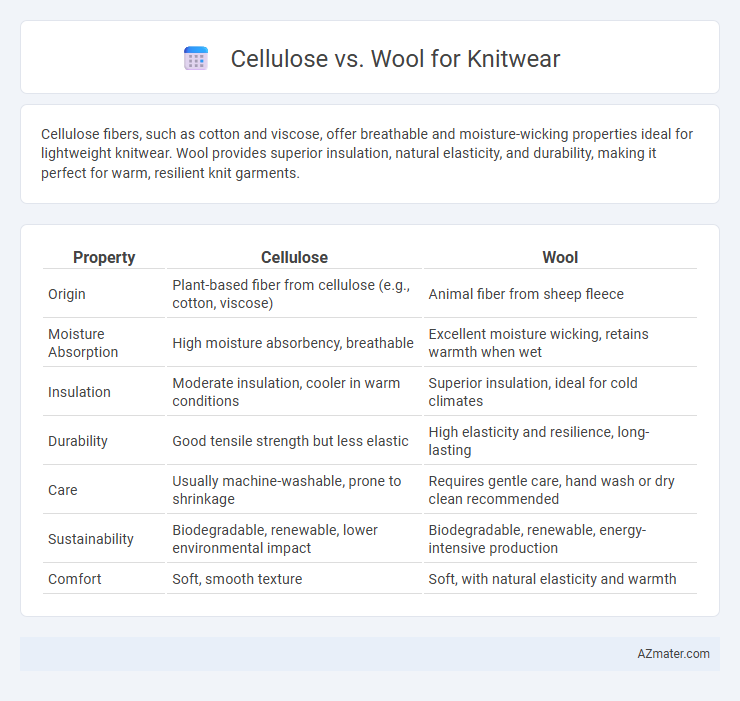Cellulose fibers, such as cotton and viscose, offer breathable and moisture-wicking properties ideal for lightweight knitwear. Wool provides superior insulation, natural elasticity, and durability, making it perfect for warm, resilient knit garments.
Table of Comparison
| Property | Cellulose | Wool |
|---|---|---|
| Origin | Plant-based fiber from cellulose (e.g., cotton, viscose) | Animal fiber from sheep fleece |
| Moisture Absorption | High moisture absorbency, breathable | Excellent moisture wicking, retains warmth when wet |
| Insulation | Moderate insulation, cooler in warm conditions | Superior insulation, ideal for cold climates |
| Durability | Good tensile strength but less elastic | High elasticity and resilience, long-lasting |
| Care | Usually machine-washable, prone to shrinkage | Requires gentle care, hand wash or dry clean recommended |
| Sustainability | Biodegradable, renewable, lower environmental impact | Biodegradable, renewable, energy-intensive production |
| Comfort | Soft, smooth texture | Soft, with natural elasticity and warmth |
Introduction to Cellulose and Wool Fibers
Cellulose fibers, derived from plant sources like cotton and linen, offer breathability, moisture-wicking properties, and biodegradability, making them ideal for lightweight knitwear. Wool fibers, sourced from animal coats such as sheep, provide exceptional insulation, elasticity, and natural water resistance, suited for warm, durable knit garments. Both fiber types serve distinct purposes in knitwear, with cellulose excelling in comfort and sustainability, while wool ensures warmth and resilience.
Sourcing and Sustainability of Cellulose vs Wool
Cellulose fibers, derived from renewable plant sources like bamboo, eucalyptus, and cotton, offer a sustainable alternative to wool by utilizing rapidly renewable resources and often requiring less water and land for cultivation. Wool, sourced from sheep, involves animal husbandry that can impact greenhouse gas emissions, land use, and biodiversity, although ethical farming practices and regenerative grazing can mitigate environmental concerns. Sustainable cellulose production emphasizes closed-loop processing and minimal chemical use, while sustainable wool relies on responsible animal welfare and pasture management to reduce its ecological footprint.
Fiber Structure and Characteristics
Cellulose fibers, derived from plant sources like cotton and bamboo, feature a linear polymer structure that provides breathability, moisture absorption, and a smooth texture ideal for lightweight knitwear. Wool fibers, composed of keratin proteins, have a unique scaly surface and crimped structure that trap air, offering superior insulation, elasticity, and moisture-wicking properties suitable for warm, durable knitwear. The hydrophilic nature of cellulose contrasts with wool's natural lanolin coating, influencing durability, softness, and moisture management in knitwear applications.
Comfort and Wearability in Knitwear
Cellulose fibers like cotton and viscose offer breathable, moisture-wicking properties that enhance comfort in knitwear, making them ideal for warm climates and sensitive skin. Wool provides superior insulation, elasticity, and natural odor resistance, ensuring warmth and durability in cooler conditions while maintaining softness with fine-grade varieties like Merino. Combining cellulose and wool in knitwear can optimize both comfort and wearability by balancing temperature regulation, moisture management, and tactile softness.
Insulation and Breathability Comparison
Cellulose fibers such as cotton and viscose provide excellent breathability, allowing moisture to evaporate quickly and keeping the wearer cool in warm conditions. Wool offers superior insulation due to its natural crimp, trapping air and retaining heat even when damp, making it ideal for cold weather knitwear. While cellulose excels in moisture management and lightweight comfort, wool outweighs in thermal regulation and long-lasting warmth.
Durability and Care Requirements
Cellulose fibers like cotton and viscose offer moderate durability for knitwear but tend to lose strength when wet, requiring gentle washing and careful drying to prevent shrinkage. Wool, a protein fiber, boasts high durability with natural elasticity and resilience, maintaining shape through wear and offering excellent insulation, though it demands specialized care such as hand washing or dry cleaning to avoid felting and shrinkage. Choosing between cellulose and wool knitwear hinges on prioritizing ease of care versus long-lasting performance in varied conditions.
Dyeing and Color Retention
Cellulose fibers, such as cotton and rayon, exhibit excellent dye absorption due to their hydrophilic nature, resulting in vibrant and long-lasting colors in knitwear. Wool, a protein fiber, tends to bond strongly with acid dyes, providing rich hues but may experience color fading with exposure to sunlight and washing if not treated properly. Advances in dyeing technology, including reactive dyes for cellulose and specialized mordants for wool, enhance color retention and vibrancy in knit garments.
Environmental Impact and Biodegradability
Cellulose fibers such as cotton and bamboo have a lower environmental impact than wool, requiring less water and energy for production while avoiding methane emissions from livestock. Wool offers natural biodegradability but takes longer to decompose compared to cellulose-based fibers, which break down more rapidly in soil due to their plant origin. Both materials are renewable, but cellulose knits generally score higher in sustainability metrics due to faster biodegradation and less intensive farming practices.
Price and Market Availability
Cellulose fibers such as viscose and lyocell generally offer lower price points compared to wool, making them more accessible for budget-conscious knitwear production. Wool, especially high-quality varieties like merino, commands higher prices due to its natural thermal insulation and durability, limiting its market availability in mass-produced knitwear. The cellulose fiber market benefits from large-scale, cost-effective production, resulting in widespread availability and diverse knitwear options.
Choosing the Best Fiber for Your Knitwear Project
Cellulose fibers like cotton and viscose offer breathability, moisture absorption, and soft drape, ideal for lightweight and summer knitwear projects. Wool provides superior insulation, elasticity, and natural wrinkle resistance, making it perfect for warm, durable knitwear suited to colder climates. Selecting between cellulose and wool depends on your project's desired warmth, texture, and care requirements, with cellulose favoring softness and breathability, and wool excelling in warmth and resilience.

Infographic: Cellulose vs Wool for Knitwear
 azmater.com
azmater.com